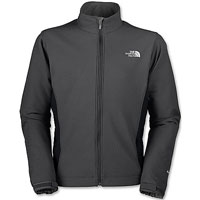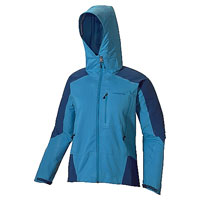Soft shells have become extremely popular backcountry (and around-town) clothing in recent years, but this rapidly growing category of stretchy, breathable outerwear can also be confusing to navigate. Here’s a basic introduction to this newest and continually expanding category of outerwear.
What Exactly is a Soft Shell?
Much of the confusion around soft shells lies with the fact that the term is loosely-defined and is used quite broadly to refer to a wide range of outerwear (largely jackets, pants, and vests).
Soft shells are breathable, wind-, water-, and abrasion-resistant outerwear made from stretchy materials designed for aerobic outdoor activities. Soft shells come in a wide range of windproofness, water resistance, breathability, stretch, and insulation, and soft shell fabrics range from light, stretchy, sweater-like knits to stiffer, laminated, dense, water-resistant wovens. Soft shell fabrics, such as Schoeller Dryskin Extreme or Polartec Power Shield, are softer (naturally) and more flexible than waterproof-breathable hard shells, like Gore-Tex. They’re more comfortable to move in and they don’t suffer from the noisy crinkliness of hard shells.
The major advantage of soft shells over waterproof hard shells is their breathability. While waterproof-breathable hard shells repel rain with laminates or coatings that allow sweat to pass back through, they also sacrifice breathability. Soft shells tradeoff complete waterproofness for two to three times more breathability than typical hard shells. This means that during highly aerobic activities, like cross-country skiing or climbing a steep trail, you won’t get soaked from sweat trapped inside your shell. This greater breathability also makes soft shells more versatile, since you won’t need to stop as often during an outing to add or remove layers to regulate your temperature or comfort level. But the tradeoff is less weather resistance. While most soft shell fabrics can withstand a light rain they will not keep you dry in a steady downpour.
When Can I Use a Soft Shell?
The short answer is any time you don’t need a completely waterproof shell. Because of their high breathability, soft shells are best for aerobic activities like hiking, climbing, cross-country and backcountry skiing, snowshoeing, and mountain biking—any time you might be sweating and don’t want that sweat trapped inside your shell. Which soft shell works best in each of those situations depends on how much water resistance and breathability you need, any insulation requirements, and your personal preferences.
What About Waterproofing?
Soft shells are not waterproof, although some are highly water-resistant and come pretty close. Many can shed hours of light, dry snowfall or even light rain while remaining reasonably breathable. In the wide range of soft shells, the more weatherproof it is the less breathable it will be (although a less breathable soft shell will still be more breathable than a hard shell).
If you need completely waterproof protection get a hard shell jacket and pants, since even a durable water repellent (DWR) treated soft shell (one with a hydrophobic coating that makes water bead up and roll off rather than soaking in) will not replace a truly waterproof hard shell when you need one in a downpour.
How Warm is It?
A soft shell is an outer layer (hence “shell”) designed for breathability and flexibility during aerobic pursuits. It acts as a barrier to the wind and some precipitation while allowing sweat to escape. While some soft shells have fleece linings or even synthetic insulation built in, soft shells are not designed primarily to insulate. Even with insulated soft shells you’ll still need to layer properly for the conditions you’ll encounter. This may mean adding a mid-layer, such as fleece, wool, down, or synthetic insulation.
Insulated linings can make a difference in the cold, but depending on when and where you use your soft shell they may also make your shell less versatile overall. Since any shell is part of a layering system, be certain you need insulation or a lining before you buy a soft shell with one. Adding or removing layers underneath your shell may allow you to regulate your temperature better in a wider range of conditions.
Enough Already, How Do I Choose a Soft Shell?
When selecting any outdoor gear or clothing you need to do an honest assessment of your performance criteria and preferences. To narrow down the soft shell choices ask yourself the following questions about how you’ll use your soft shell. While you may use your soft shell in totally different ways or conditions on occasion, how will you use it 90 percent of the time?
-
Where and when will I use the soft shell?
What are the typical weather conditions and climate you’ll encounter?
Will conditions be wet (ice climbing) or dry (desert hiking)?
Will temperatures be very cold (consider a fleece lining or insulation) or moderate to mild (forget the insulation)?
Do you need serious protection from the elements? If so, what exactly are those elements?
-
How will I use the soft shell?
Will you be stopping and starting often or moving fast and continuously?
Do you need insulation in your shell or would you rather add mid-layers as necessary?
What part will the shell play in your multiple-layer clothing system?
Your answers to these questions will help you decide between the amount of water resistance and the amount of breathablity (you can’t have both) you’ll need for the conditions you’ll typically encounter and the way you’ll use your soft shell. Choosing a soft shell comes down to how much breathability, water-resistance, and insulation you need.
Mild, dry conditions: More breathability, less water resistance, no insulation
Cold, wet conditions: Less breathability, more water resistance, possibly some insulation
High aerobic output: More breathability, less or no insulation
Low aerobic output: Less breathability, possibly some insulation
For example:
-
If you’ll typically experience mild, dry conditions during moderate to highly aerobic activity you might choose a stretchy, lightweight knit or woven fabric with high breathability (such as The North Face Apex Pneumatic or Mountain Hardwear Offwidth).
-
For colder, dry conditions you might want a mid-weight, more densely woven fabric with good wind resistance, moderate breathability, and possibly a lining or insulation (such as the Arc'Teryx Sigma SV or Cloudveil Switchback).
-
And in cold, wet conditions you might want a heavier fabric, with the highest water resistance, but less stretch, possibly lined with fleece (such as the Marmot Ascend, Mountain Hardwear Hooded Synchro, or Patagonia Ready Mix).
What About Features?
After you’ve figured out how much breathability, weatherproofness, and insulation (if any) you need, consider whether you want or need specific features, such as a hood, pit zips, adjustable cuffs, or pockets. And most important, don’t forget a good fit. Since you’ll most likely be wearing your soft shell during active pursuits, make sure the cut and stretch of the fabric give you a full range of motion for your favorite activity, whether you’ll be ice climbing, backcountry skiing, or hiking a steep trail. Soft shells tend to be cut trimmer than hard shells. So make sure the model and size you buy will work with any layers you’ll add under or over it.
Now that you better understand soft shells, check out Trailspace’s user reviews and product information on hundreds of soft shell jackets, soft shell pants, and soft shell vests to find the right piece for you and your next outdoor adventure.

 by Alicia MacLeay
by Alicia MacLeay
















